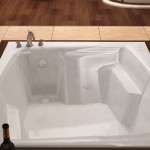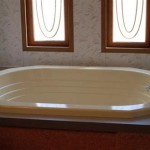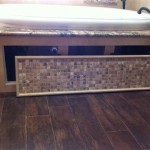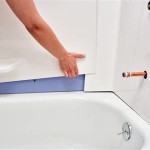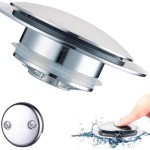Jacuzzi vs. Bathtub: Understanding the Key Differences
The terms "Jacuzzi" and "bathtub" are often used interchangeably, but they represent distinct bathing experiences with differing functionalities. While both serve the fundamental purpose of personal hygiene and relaxation, their designs, features, and intended uses vary significantly. Understanding these differences is crucial when considering which option best suits individual needs and preferences for a bathroom renovation or new construction project.
Hydrotherapy Functionality
The primary differentiator between a Jacuzzi and a standard bathtub lies in its hydrotherapy capabilities. A Jacuzzi, often generically referred to as a whirlpool or hot tub, is equipped with jets that propel water, creating a massaging effect on the body. These jets are strategically positioned to target specific muscle groups, providing therapeutic relief from soreness, stiffness, and stress. The intensity and direction of the jets are typically adjustable, allowing users to customize their hydrotherapy experience.
In contrast, a standard bathtub lacks these hydrotherapy features. Its primary function is to hold water for soaking and washing. While adding bath salts, aromatherapy oils, or utilizing a bath pillow can enhance the relaxing experience, a standard bathtub does not offer the mechanical massaging action of a Jacuzzi.
The engineering behind the Jacuzzi's hydrotherapy system involves a pump that circulates water from the tub through the jets. A heater maintains the water temperature at a consistently warm level, further contributing to muscle relaxation. Some advanced Jacuzzi models incorporate air jets, which introduce bubbles into the water, creating a gentler, more effervescent massage.
The therapeutic benefits of a Jacuzzi extend beyond mere relaxation. The massaging action can improve blood circulation, reduce inflammation, and alleviate pain associated with conditions such as arthritis and fibromyalgia. The warm water also helps to loosen stiff joints and muscles, preparing the body for physical activity or aiding in post-workout recovery.
Design and Installation Considerations
The design and installation process for a Jacuzzi and a bathtub differ significantly due to their varying complexities. Standard bathtubs are generally simpler to install, requiring basic plumbing connections for water supply and drainage. They are available in a wide range of materials, shapes, and sizes, offering flexibility in terms of bathroom layout and aesthetic preferences.
Jacuzzis, on the other hand, necessitate more intricate installation procedures. In addition to standard plumbing connections, they require electrical wiring to power the pump, heater, and jets. The installation must comply with electrical codes to ensure safety and prevent electrical hazards. Furthermore, the weight of a filled Jacuzzi can be substantial, potentially requiring structural reinforcement of the flooring.
The design of a Jacuzzi often incorporates features such as molded seats, armrests, and headrests to enhance comfort during hydrotherapy sessions. The shape and size of the Jacuzzi must be carefully considered to accommodate the number of users and the available space. Some Jacuzzi models are designed for indoor use, while others are specifically engineered for outdoor installation, with features such as weather-resistant materials and insulated covers.
The maintenance requirements for a Jacuzzi are also more demanding than those of a standard bathtub. Regular cleaning is essential to prevent the build-up of bacteria, algae, and mineral deposits in the jets and plumbing system. Periodic flushing of the jet system with a specialized cleaning solution is recommended to ensure optimal performance and hygiene. Water chemistry management is also important, particularly for outdoor hot tubs, to maintain water clarity and prevent corrosion of the equipment.
Cost and Maintenance
The initial cost of a Jacuzzi is significantly higher than that of a standard bathtub. This price difference reflects the more complex engineering, additional features, and higher-quality materials used in Jacuzzi construction. The installation costs are also higher due to the need for specialized electrical and plumbing work.
Beyond the initial investment, the ongoing operating costs of a Jacuzzi are also higher. The heater consumes electricity to maintain water temperature, and the pump requires power to circulate the water through the jets. Regular cleaning and maintenance also contribute to the overall cost of ownership. Chemicals used to maintain water quality are an ongoing expense.
Standard bathtubs, being simpler in design and lacking electrical components, have lower initial costs and minimal operating expenses. The primary maintenance requirement is regular cleaning to prevent the build-up of soap scum and grime. The cost of cleaning supplies is typically less than the cost of chemicals required for Jacuzzi water maintenance.
The lifespan of both Jacuzzis and bathtubs can vary depending on the quality of materials, construction, and maintenance practices. High-quality Jacuzzis, properly maintained, can last for many years. Similarly, well-maintained bathtubs can provide decades of reliable service. However, neglecting maintenance can shorten the lifespan of either type of bathing fixture.
The environmental impact also differs. Jacuzzis generally consume more water and energy than standard bathtubs. Filling a Jacuzzi requires a larger volume of water, and the heating system consumes electricity. Opting for energy-efficient Jacuzzi models and implementing water conservation practices can help to mitigate these environmental impacts.
Ultimately, the choice between a Jacuzzi and a bathtub depends on individual priorities and budgetary constraints. For those seeking therapeutic hydrotherapy and willing to invest in the higher cost and maintenance requirements, a Jacuzzi may be the ideal choice. For those prioritizing simplicity, affordability, and ease of maintenance, a standard bathtub offers a practical and reliable solution.
Before making a decision, it is advisable to research different models, compare features and prices, and consult with a qualified contractor to assess the feasibility of installation and estimate the associated costs. Careful planning and consideration will ensure that the chosen bathing fixture provides years of enjoyment and meets individual needs and preferences.

Difference Between Spa Bathtub And Jacuzzi Acrolite Bathtubs

7 Differences Between Jacuzzi And Bathtub

Difference Between Hot Tub And Jacuzzi Bathtub

What Is The Difference Between A Jacuzzi And Bathtub

Difference Between Jacuzzi And Hot Tub

Jacuzzi Vs Hot Tub

Hot Tub Vs Jetted Bathtub

10 Differences Between Jacuzzi And Bathtub What You Need To Know Before Buy

Jacuzzi Vs Bathtub Differences You Should Know Kohler

Hot Tub Vs Jacuzzi What S The Difference Platinum Spas

